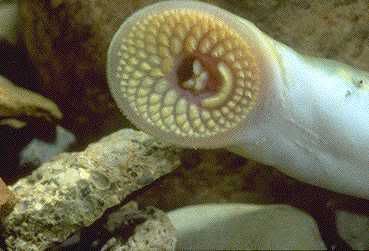
The Ohio lamprey is a 2 foot long, eel-looking fish, which is native to streams and rivers in the eastern Midwest (or western East) states. In their two years as adults they parasitize fish by sucking onto other fish with its gaping maw (also known as an oral disc; lamprey don’t have jaws), where it proceeds to suck the host’s blood1.
Before the parasitic adult stage, baby lamprey (now isn’t that an adorable mental image?) spend four years buried in the riffles of small streams with their head poking out, filter feeding on algae and plankton. After this time, they develop eyes and an oral disc, make their way to a larger river, and find a suitable host. I’m not sure if how frequently they switch hosts, and it’s possible that the scientists don’t know either. After their first year, the lamprey disengage themselves from their hosts, and make their way back to the river that spawned them. Here, they will build a nest, often with the cooperation of other spawning lamprey, lay their eggs in the gravel, and die.
Quick quiz! What have all the aquatic vertebrates I’ve written about had a problem with?
Time’s up! If you guessed “Dams,” you’re correct! With the lamprey, dams stop them from being able to move to their feeding grounds as adults. The entrance of more silt in the streams, usually from runoff, gives the juveniles problems with filter feeding.
There are people working on fixing these problems, through land conservation and habitat monitoring. Determining good solutions for lamprey preservation requires that we learn a lot more about them. Sampling is hard due to their habits of being either buried in a stream or a fish for five-sixths of their life. Getting people interested in them is the first step toward saving them, so I’m trying to do my part.
1Can anybody think of a parasitic vertebrate that isn’t a lamprey? I know of the male anglerfish, but that hardly counts.





No comments:
Post a Comment